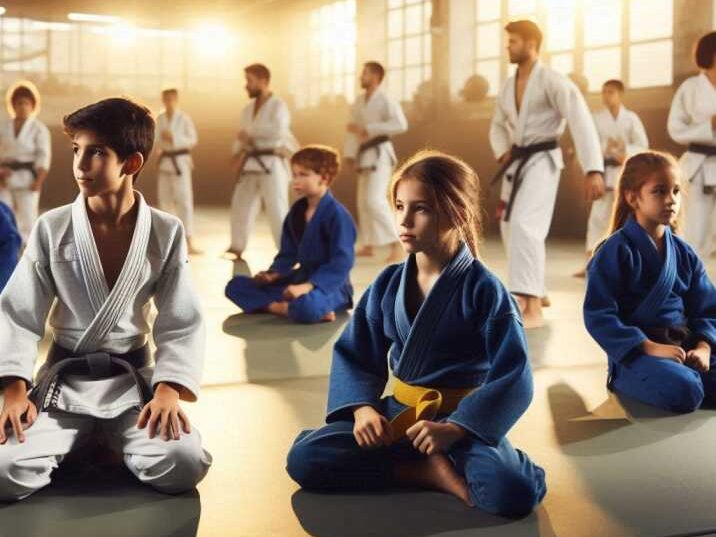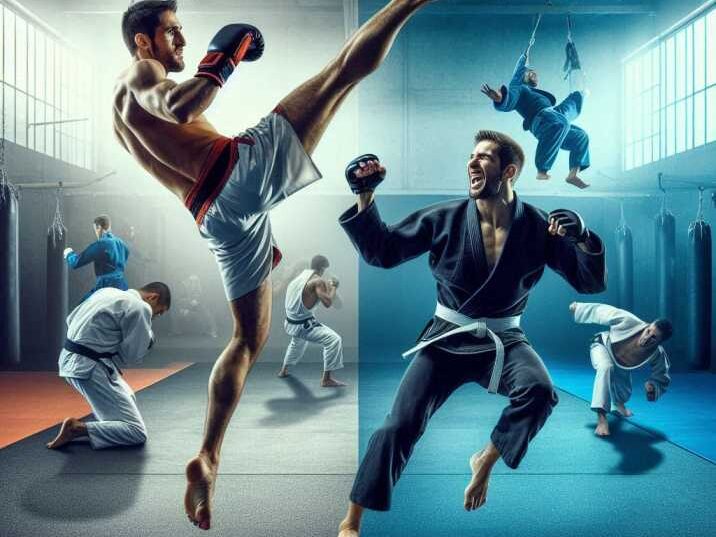Introduction
Table of Contents
Martial arts are not just about fighting; they teach discipline, focus, and self-control. Some styles focus more on offense, while others emphasize defense. But what if you could master both? In this guide, we explore the best martial arts for offense and defense, helping you choose the right style that offers a perfect balance between attack and protection.
Training in martial arts requires concentration and discipline, which can help improve focus in school and daily activities. Whether you want to learn for self-defense, competition, or fitness, these martial arts will prepare you for both offense and defense.

Top Martial Arts for Offense and Defense
1. Brazilian Jiu-Jitsu (BJJ) – The Ground Fighting Expert
Strengths:
- Focuses on grappling and submissions.
- Uses an opponent’s force against them.
- Excellent for self-defense against larger attackers.
Offensive Skills:
- BJJ practitioners utilize chokes and joint locks to neutralize opponents without relying on brute strength. These techniques allow a smaller fighter to control and submit a larger opponent.
- Sweeps and reversals are key offensive moves, enabling fighters to escape bad positions and gain dominant control in a fight.
Defensive Skills:
- BJJ is known for its ability to escape from holds and locks, giving practitioners a strong defense against physical attacks.
- Fighters learn to control an opponent without striking, using techniques like guard positions and positional control to stay safe in real combat scenarios.
2. Muay Thai – The Art of Eight Limbs
Strengths:
- Uses punches, kicks, elbows, and knees.
- Effective in both close-range and long-range combat.
- Powerful offensive and defensive techniques.
Offensive Skills:
- Muay Thai fighters execute strong striking combinations, mixing punches, kicks, knees, and elbows to overwhelm their opponents.
- The sport is known for its devastating knee and elbow attacks, which can deliver significant damage in close combat situations.
Defensive Skills:
- Fighters use blocking and checking kicks to minimize incoming strikes and prevent injury.
- Effective clinching techniques allow them to control their opponent, disrupting attacks while setting up their own counter-strikes.
3. Krav Maga – The Ultimate Self-Defense System
Strengths:
- Designed for real-life combat situations.
- Simple yet effective techniques.
- Emphasizes quick, decisive action.
Offensive Skills:
- Krav Maga employs aggressive counter-attacks, aiming to end confrontations quickly and decisively.
- Fighters are trained to strike weak points like the eyes, groin, and throat, making their attacks more effective in dangerous situations.
Defensive Skills:
- The system teaches disarming techniques against weapons, allowing practitioners to defend themselves in life-threatening encounters.
- Escape techniques help fighters break free from grabs and holds, ensuring they can remove themselves from dangerous situations with minimal harm.
4. Boxing – The Science of Striking
Strengths:
- Develops powerful punches and footwork.
- Trains speed and accuracy.
Offensive Skills:
- Boxers utilize jabs, hooks, and uppercuts to create openings and wear down opponents with precise strikes.
- Combination attacks are key to overwhelming an opponent and gaining control of the fight.
Defensive Skills:
- Defensive techniques such as dodging, blocking, and countering punches help boxers avoid taking damage while preparing counter-attacks.
- Footwork is crucial for maintaining distance and positioning, allowing fighters to stay agile and react effectively.
5. Judo – The Art of Throws
Strengths:
- Focuses on throws, trips, and takedowns.
- Uses an opponent’s momentum against them.
Offensive Skills:
- Judo relies on powerful throws and takedowns, using balance and timing to take an opponent to the ground.
- Pinning techniques allow a Judoka to control and immobilize their opponent, often leading to a submission.
Defensive Skills:
- Judo practitioners excel at escaping from holds and grips, making it difficult for an opponent to maintain control.
- The art emphasizes leverage over brute force, allowing smaller individuals to defend effectively against larger attackers.
6. Taekwondo – The Kicking Powerhouse
Strengths:
- Specializes in high, fast kicks.
- Enhances speed, agility, and flexibility.
Offensive Skills:
- Taekwondo fighters use spinning and flying kicks to deliver high-speed, powerful strikes that can knock out an opponent.
- Their rapid kicking combinations allow them to maintain offensive pressure while keeping a safe distance.
Defensive Skills:
- Taekwondo includes counter-attacks using kicks, allowing fighters to defend while striking simultaneously.
- Blocks and evasive movements help deflect incoming attacks and minimize damage.
7. Karate – The Balanced Striking Art
Strengths:
- Well-rounded with strikes, blocks, and kata training.
- Focuses on timing and precision.
Offensive Skills:
- Karate includes strong punches, kicks, and knee strikes, making it an effective striking martial art.
- Practitioners learn to execute quick, decisive counter-attacks, using precision and speed to strike effectively.
Defensive Skills:
- Blocking and deflecting attacks is a fundamental part of Karate, reducing the impact of incoming strikes.
- The style teaches controlled movements to maintain balance, ensuring fighters stay steady while defending and countering.
Table: Best Martial Arts for Offense and Defense
| Martial Art | Best For | Key Strengths |
|---|---|---|
| BJJ | Ground Defense | Submissions & Grappling |
| Muay Thai | Striking Power | Kicks, Elbows, Knees |
| Krav Maga | Real-Life Self-Defense | Aggressive Techniques |
| Boxing | Hand Strikes | Speed & Precision |
| Judo | Throws & Control | Takedowns & Balance |
| Taekwondo | Kicking Attacks | High-Speed Kicks |
| Karate | Balanced Training | Strikes & Blocks |

Conclusion
The best martial art for you depends on your goals. If you want strong striking power, Muay Thai or Boxing might be best. If you prefer self-defense, BJJ or Krav Maga is ideal. Judo and Karate offer a balanced mix of both. Training in martial arts not only teaches self-defense but also improves focus, discipline, and confidence.
FAQs
1. What is the best martial art for beginners?
- Karate and Judo are great for beginners because they focus on fundamentals and discipline.
2. Can I learn multiple martial arts at once?
- Yes, but it’s best to master one before adding another to avoid confusion.
3. Which martial art is best for self-defense?
- Krav Maga is the most effective for real-life self-defense situations.
4. What is the easiest martial art to learn?
- Boxing and Taekwondo are relatively easy to start with due to their structured training.
5. How long does it take to become good at martial arts?
- It depends on the style and training frequency, but most take at least 6 months to gain basic proficiency.

